If you’re looking to adopt an ancient dog breed with a sweet face and loyalty to spare, you may be looking for a Chinese shar-pei. The Chinese shar-pei (also referred to as simply shar-pei or Peis) remains a regal breed and a one-in-a-million guard dog. Wary of strangers and affectionate with family, the shar-pei makes a great addition to families with older children.
Keep reading to learn more about the growth milestones, training tips, and things to know about a shar-pei — including how much they’ll weigh at full maturity and when to spay or neuter your shar-pei.
Breed Summary

Shar-peis have an iconic smushed-face appearance from their fur folds.
©Sue Thatcher/iStock via Getty Images
The gorgeous shar-pei stands about 18 to 20 inches tall and weighs between 45 and 60 pounds, though some breed individuals report heavier weights outside the breed standard. For a larger dog, the shar-pei has an average-length lifespan of between eight and 12 years old.
The temperament of a shar-pei is described as loyal, independent, and calm according to the American Kennel Club. Shar-peis have a unique appearance — a “smush” face with wrinkles, a curly tail, and a sandpaper-esque coat. The shar-pei puppy needs consistent training to grow up well-adjusted, behaved, and socialized.
Shar-Pei Growth and Weight Chart by Age
While weights may vary based on breed individuals, the chart below provides a rough estimation of the growth progression of a shar-pei by gender.
| Age | Male Weight | Female Weight |
|---|---|---|
| Birth | 7 lbs. | 6 lbs. |
| 1 Month | 9.4 lbs. | 7.2 lbs. |
| 6 Weeks | 11 lbs. | 8.1 lbs. |
| 2 Months | 12.4 lbs. | 10.6 lbs. |
| 3 Months | 16.1 lbs. | 13.8 lbs. |
| 4 Months | 20.2 lbs. | 17.3 lbs. |
| 5 Months | 24.8 lbs. | 21.2 lbs. |
| 6 Months | 29.5 lbs. | 25.3 lbs. |
| 7 Months | 34 lbs. | 29.1 lbs. |
| 8 Months | 38.1 lbs. | 32.7 lbs. |
| 9 Months | 41.7 lbs. | 35.8 lbs. |
| 10 Months | 44.7 lbs. | 38.3 lbs. |
| 11 Months | 47.1 lbs. | 40.3 lbs. |
| 12 Months | 48.9 lbs. | 41.9 lbs. |
| 2 Years | 52 lbs. | 45.4 lbs. |
When Will My Shar Pei Stop Growing?
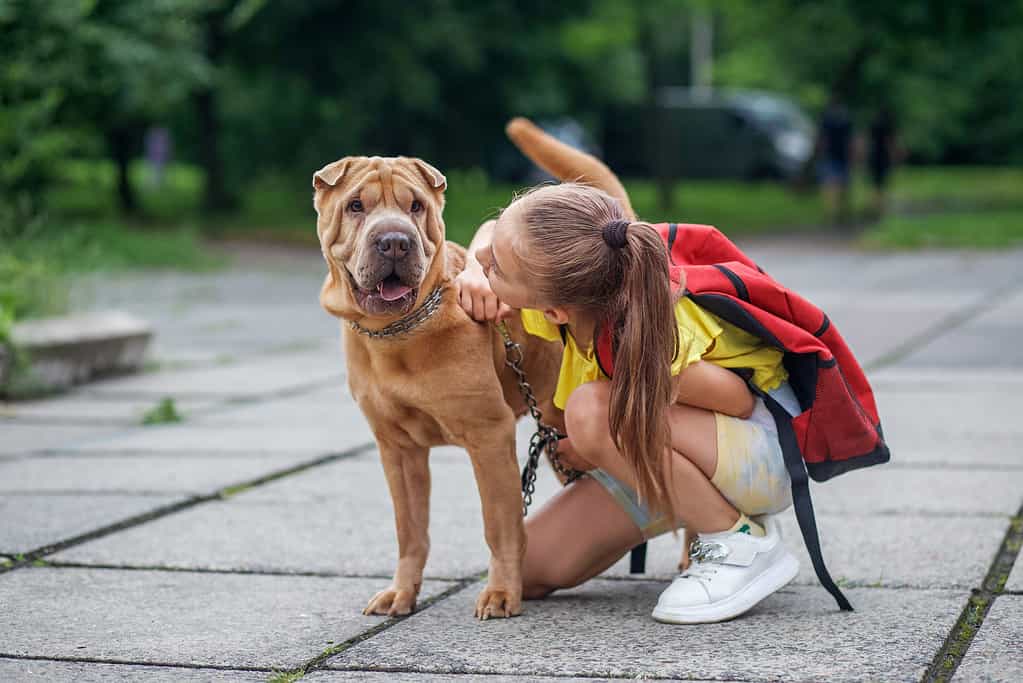
Shar-peis will grow the most between the first three to 14 weeks of life.
©Olha Romaniuk/iStock via Getty Images
Dr. Mollie Newton, an experienced veterinarian and the owner of PetMeTwice.com lent her expertise to AZ Animals on the subject of shar-peis. She discussed at length the growth milestones, trainability, and temperament of the breed.
“[Shar-peis are] known for their distinct wrinkles, which are most prominent during puppyhood. As they grow, usually reaching their full size by nine to 12 months, these wrinkles become less pronounced,” Dr. Newton asserted.
As a shar pei grows, owners should keep an eye on their skin and diligently work to involve them in socialization situations to ensure good behavior down the line. Dr. Newton confirmed these training considerations, stating that “Key developmental milestones for shar-peis include socialization, particularly between three and 14 weeks of age. It’s crucial to monitor their skin during growth for any signs of irritation or infection, common in this breed due to their folds.”
How Big Will My Shar-Pei Be When It’s Fully Grown?
Based on breed standards, the “normal” shar-pei will grow to 18 to 20 inches in height (at the withers) and a weight between 45 and 60 pounds at full maturity. The American Kennel Club, nor the Chinese Shar-Pei Club of America request a standard length for the dog’s body.
When Should My Shar-Pei Be Spayed or Neutered?
The recommended age for spaying or neutering your shar-pei depends largely on their physical development. Owners should refer to their vet’s suggestion on the proper surgery time. On average, shar-peis get neutered within the window of four months (for neutering, specifically) to a year.
The shar-pei’s medium-large size makes the surgery a bit less difficult for veterinarians; however, the health concerns and complications of the shar-pei breed can complicate medical procedures. Healthy shar-peis that do well under anesthesia can usually get spayed before their first heat cycle or neutered before their first birthday.
When Should My Shar-Pei Be House Broken?

Shar-peis remain relatively easy to housebreak.
©djiledesign/iStock via Getty Images
Thanks to the shar-pei breed’s intelligence, it’s relatively easy to housebreak a shar-pei. Within a few weeks of starting training, your shar-pei should be almost completely housebroken. If you start potty training the week you bring your eight-week-old shar-pei puppy home, they should be fully housebroken by the four or five-month mark.
Consistency and patience remain vital virtues when house training any dog, so the shar-pei is no different. When you start potty training, take your shar-pei outside every two to three hours. Outside of this consistent time frame, take your pup out immediately after meals, play, naptime, or when they drink a lot of water at once.
When accidents do happen inside, bring your shar-pei outside to help them understand the right place to potty. When you come back inside, clean up the mess immediately and use cleaners that will rid the floor, wall, or carpet of the ammonia in your shar-pei’s urine. If you fail to remove the scent, your shar-pei might start to believe that’s their “spot” to potty.
When Should My Shar-Pei Stop Eating Puppy Food?
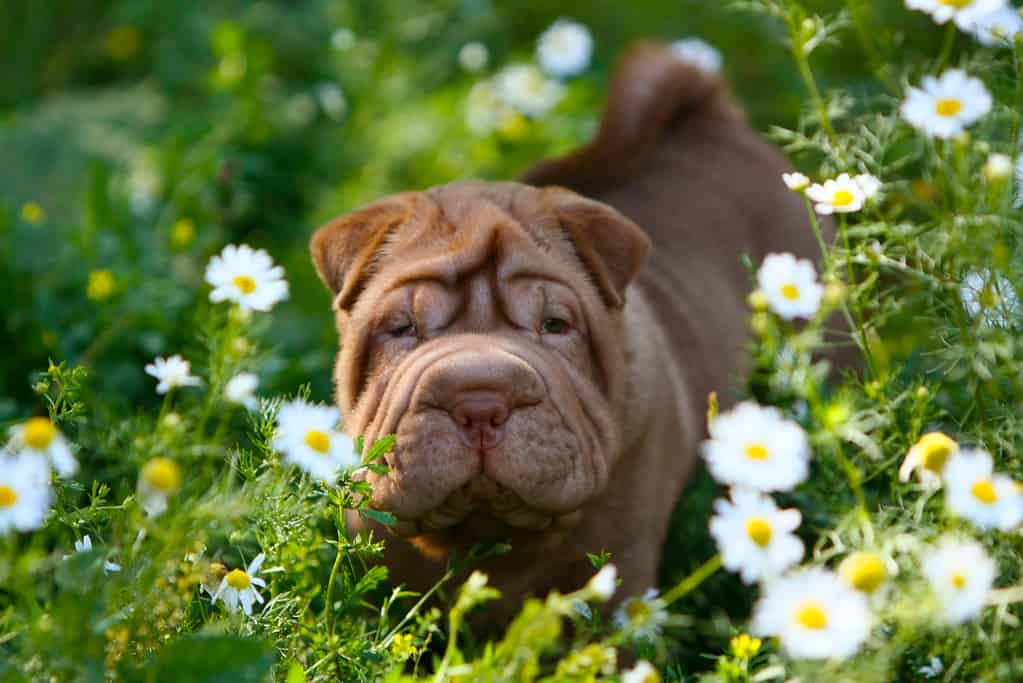
Ask your vet when your shar-pei should start its transition to adult food around the nine-month mark.
©Nadezhda Braninger/iStock via Getty Images
Shar-pei puppies can begin transitioning to adult food at the end of their first year of life. By 12 months old, they’ve grown to almost their mature weight, have lost all their baby teeth, should be potty trained, and may have even been spayed or neutered. As with most decisions regarding your pet’s health, consult your veterinarian for the final confirmation to switch — as transitioning too early or too late can impact a shar-pei’s growth and development.
When you switch your shar-pei to adult food from puppy food, do it in stages. If you change their food “cold turkey,” you won’t give your shar-pei’s stomach enough time to acclimate to the difference in nutrients and flavors. The bacteria within their intestines will struggle to keep up with the switch. Take time and care in switching, as failing to do so may result in vomiting, diarrhea, or gastrointestinal discomfort for your pup.
When Will My Shar-Pei Start Losing Teeth?
According to Dr. Newton, shar-peis will begin to teeth around four to six months of age. Teething will last a few weeks and you may or may not see tiny puppy teeth fall out around your home. Like many other breeds, shar-peis remain at risk of developing dental disease. Brushing your shar-peis teeth twice a week — and starting the routine when they’re very young — has the potential to elongate your dog’s life by years. How? By avoiding dental disease, you’ll also improve your shar-pei’s kidney, liver, heart, and joint health.
During teething, owners can expect an increase in their shar-pei’s general discomfort. Always use dog-friendly toys and chews. Chew toys soaked in chicken broth or frozen, vet-approved vegetables are great boredom-busters that soothe your shar-pei puppy’s sore gums.
When Should I Start Training My Shar-Pei?
As soon as you get your shar-pei home, you can start training them. Thanks to the independent, stubborn streak that runs through most shar-peis, consistency, and patience early in training will make the dog much easier to train as it ages. It also establishes a mutually respectful relationship — a must when training your dog.
“Training a shar-pei demands a patient and consistent approach,” confirmed Dr. Newton. “While they are intelligent dogs, their stubborn streak can be a challenge. Employing positive reinforcement techniques, such as rewards and praise, proves most effective in eliciting desired behaviors.”
Dr. Newton suggested early, consistent training to maximize a shar-pei’s ability to grow up without behavioral issues. “It’s paramount to commence training early and maintain consistency throughout their development to counteract their inherent wariness and mitigate potential aggression tendencies,” she said.
What Cues Should I Teach My Shar-Pei First?

Shar-pei training should include leash manners.
©Andrey Babeshkin/iStock via Getty Images
Outside of the standard three “sit,” “stay,” and “come” commands, shar-pei parents will want to focus on a few other commands to make life more enjoyable. They include:
- Reinforcing recall.
- Up/on and down/off.
- Leash manners.
The shar-pei’s independence and bulky body create a perfect storm for a walk-gone-awry as a puppy. By working consistently on recall — that supersedes any external stimuli a shar pei might find interesting — you’ll provide your shar-pei with the tools to stay safe in hectic situations.
The up/on and down/off commands come in handy for shar-pei puppy parents who need a way to control jumping or climbing. Suppose you’re trying to eat on the couch or are welcoming a beloved family friend into the door. In that case, these commands help control your shar-pei’s excitement and draw a clear boundary between what is acceptable and unacceptable behavior.
Teaching leash manners can start in shar-pei puppyhood. Proper leash manners include sitting at the door for you to put their collar, harness, and/or leash on; understanding how to walk beside you on a leash; and avoiding pulling on the leash when on a walk. As your shar-pei gets older, you can add more nuanced cues to the leash manners you want them to have, including letting you go through a threshold first and turning with you during a walk.
When interacting in any situation, remember that positive reinforcement remains the best way to train your dog.
When Will My Shar-Pei Calm Down?
While the shar-pei’s temperament as a fully-matured dog is calm, shar-pei puppies have their share of fun for about two years — keeping owners on their toes the entire time. Even owners of four-year-old shar-peis cite their dog as still having “puppy energy,” so it remains specific to breed individuals.
On average, shar-peis don’t have the same puppy energy and uncontrollable hyperactivity as some smaller breeds (like the Jack Russell terrier). What they do have is a heaping helping of attitude and overprotectiveness — and that’s where owners have their work cut out for them.
The puppy stubbornness of a shar-pei should mellow out after several months with consistent training. As mentioned above, because shar-peis have a streak of independence in their temperaments, owners need to train their shar-pei well to avoid issues (like a wild or disobedient dog) down the line.
“The socialization process should expose them to various people, animals, and environments,” added Dr. Newton. “[This] temper their protective instincts and ensure they interact positively in different situations.”
Common Health Issues Your Shar-Pei Might Experience

Unfortunately, shar-peis can develop a list of ocular diseases.
©djiledesign/iStock via Getty Images
Shar-pei dogs have several interesting and unique health concerns not many other breeds worry about. Outside of some of the common health issues like hypothyroidism, hip dysplasia, and patella luxation, shar-peis have an increased risk of eye issues. Just a few of the ocular disorders a shar-pei can develop include:
- SARDS, which stands for Sudden Acquired Retinal Degeneration Syndrome and affects the retina of dogs. It leads to acute, irreversible blindness.
- Glaucoma, an illness in which fluid doesn’t drain properly from a dog’s eyes and increases the pressure within the organ.
- Entropion, in which a dog’s eyelid rolls inward instead of outward. This interferes with vision and causes trauma to the dog’s cornea.
- Retinal dysplasia, an ocular disease that can lead to blindness.
Shar-peis also tend to develop skin issues like skin fold infections (especially on the dog’s face) and swollen hock syndrome (also known as familial shar-pei fever).
Pictures of Shar Pei as Puppies

Shar-peis will grow into their wrinkles as they age.
©Ljupco/iStock via Getty Images
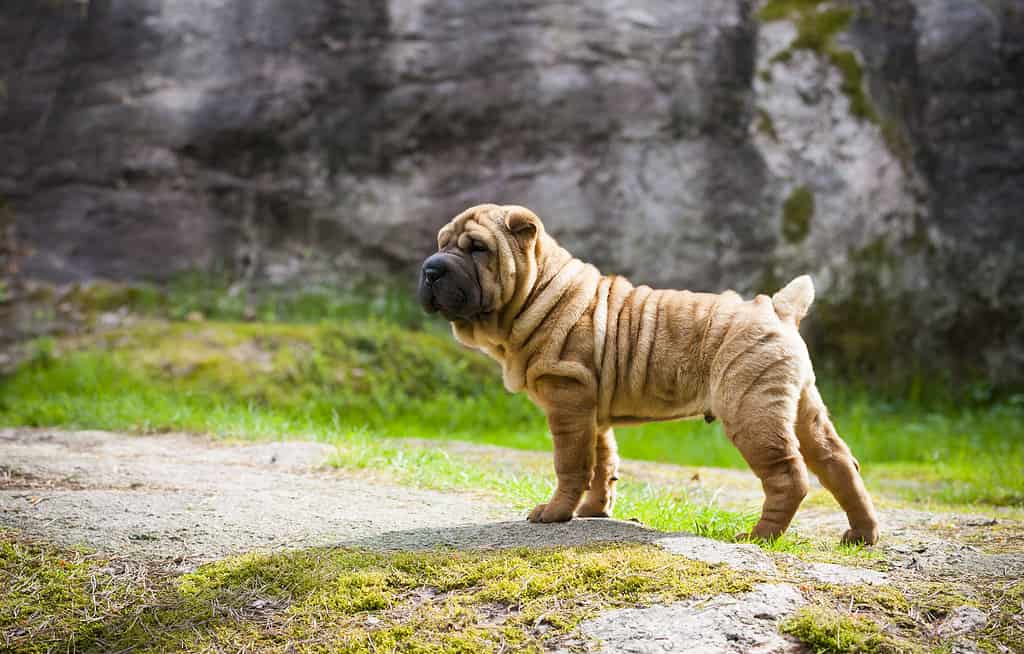
Shar-pei puppies can begin training at eight weeks old.
©Ansaharju/iStock via Getty Images

The typical size of a shar-pei litter hovers between four and six puppies.
©slowmotiongli/iStock via Getty Images
Pictures of Shar Pei at 6 Months

Shar-peis love a job to do, as they were bred to hunt and guard livestock.
©simplytheyu/iStock via Getty Images

Owners need to clean between wrinkles and folds to maintain their shar-pei’s health.
©zokov/iStock via Getty Images

Some shar-peis have a speckled blue tongue.
©slowmotiongli/iStock via Getty Images
Pictures of Fully Grown Shar Pei
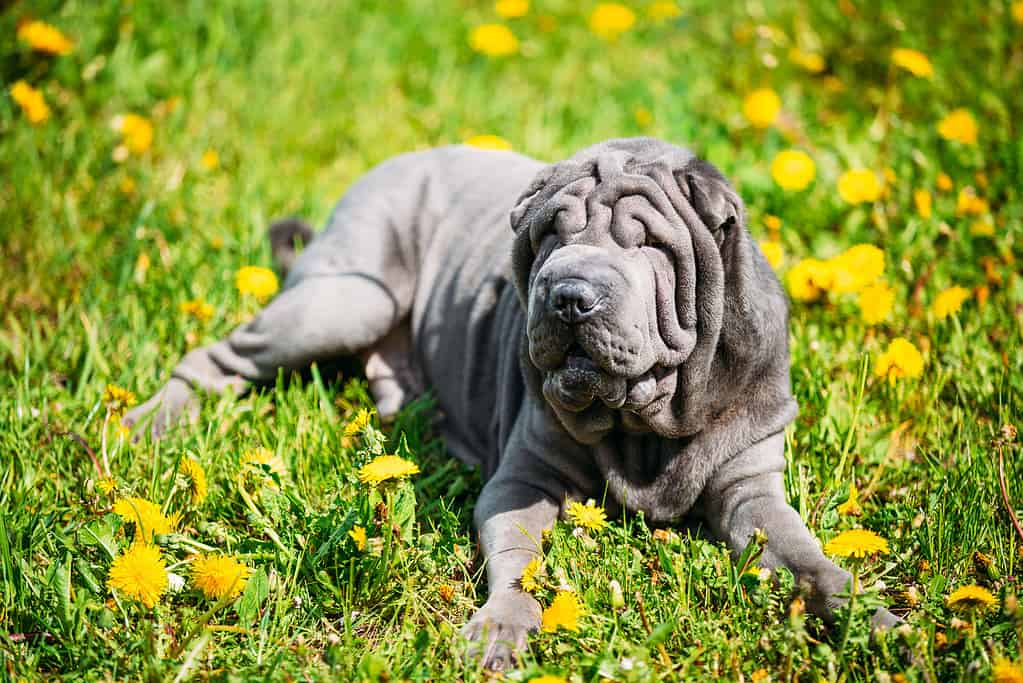
While tan is the most common, shar-peis come in several colors — like blue.
©Ryhor Bruyeu/iStock via Getty Images
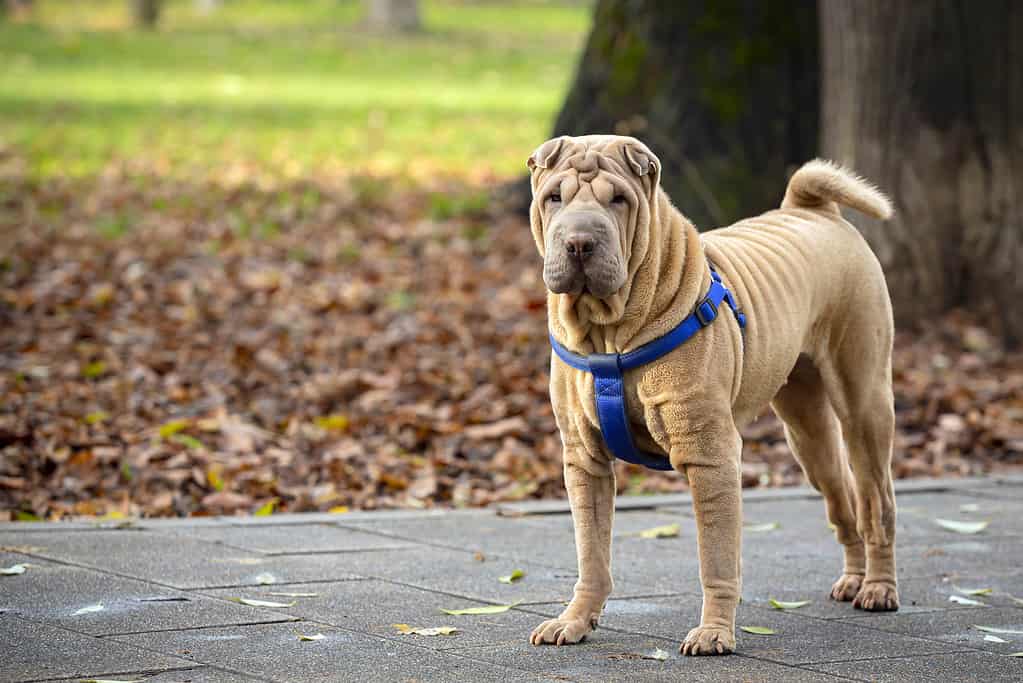
The Shar-pei is a dog breed from southern China.
©Andrey Kanyshev/iStock via Getty Images

Adult shar-peis make great companion dogs.
©marcelinopozo/iStock via Getty Images
The photo featured at the top of this post is © Nadezhda Braninger/iStock via Getty Images
Ready to discover the top 10 cutest dog breeds in the entire world?
How about the fastest dogs, the largest dogs and those that are -- quite frankly -- just the kindest dogs on the planet? Each day, AZ Animals sends out lists just like this to our thousands of email subscribers. And the best part? It's FREE. Join today by entering your email below.
Thank you for reading! Have some feedback for us? Contact the AZ Animals editorial team.







